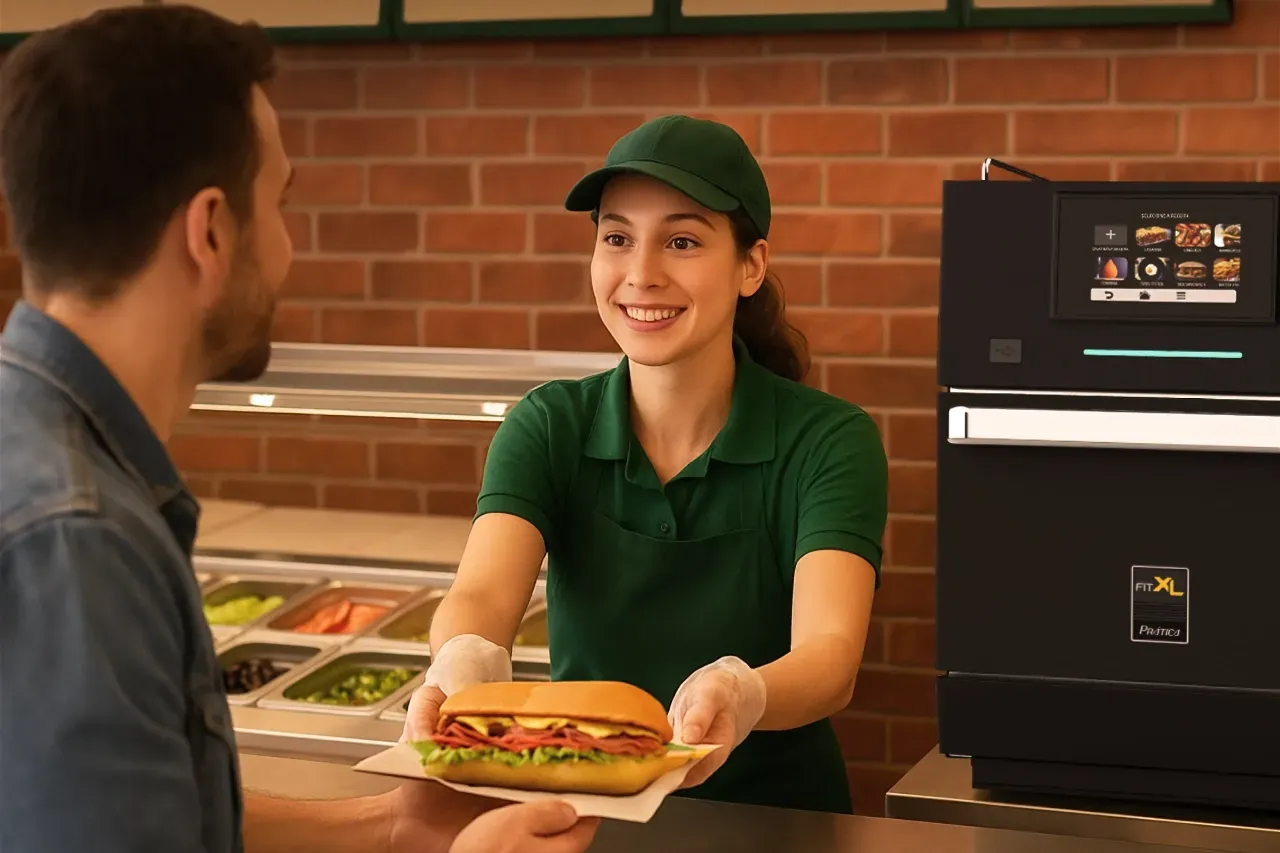Modern life is defined by speed.
Every aspect of our daily routine, from professional tasks to leisure activities, is shaped by the demand for efficiency.
Nobody has time to waste, not even when it comes to eating.
Consumers increasingly eat on the move, during their commute, at their desks, or while rushing between commitments.
This reality puts tremendous pressure on foodservice businesses.
Whether you run a high-end restaurant, a café, a food truck, or a canteen in a corporate building, you face long queues of customers who expect not only good food, but also fast food.
This dual demand for quality and speed is one of the main reasons why speed ovens have become indispensable equipment for the modern foodservice industry.
Meeting the Demand for Ultra-Fast Service
One of the primary drivers behind the adoption of speed ovens is the rising demand for ultra-fast service.
Even in cafés or restaurants where customers once tolerated longer waits, the expectation today is different.
People want their meals prepared quickly, even when they are supposedly on their free time.
The importance of speed is amplified in locations such as:
- Transport hubs: metro stations, airports, and train stations.
- Street food settings: food trucks and kiosks.
- Institutional environments: schools, universities, and canteens in commercial buildings.
- Food courts: where competition is high and speed often determines customer choice.
Speed ovens are designed to handle these high-pressure environments by delivering meals at a pace traditional ovens cannot match, without compromising on quality.
Guaranteeing Standard Quality Every Time
Consistency is critical in foodservice.
Customers expect the same flavour, texture, and presentation every time they visit your business.
An inconsistent product undermines trust and can quickly damage reputation.
Speed ovens address this challenge by combining advanced microwave technology with controlled impinged air systems.
Through touchscreen settings, operators can precisely adjust the percentage of microwave incidence and airflow distribution. This ensures:
- Uniform heating.
- Attractive finishing.
- Reproducible results for every order.
By delivering standardised quality, speed ovens help businesses maintain customer satisfaction while meeting time constraints.
High-Quality Finishing with Controlled Technology
It is not enough to simply heat food quickly—presentation matters too.
Poorly heated or unevenly browned dishes drive customers away.
Speed ovens excel in this area by ensuring that food is both properly cooked and attractively finished.
The technology behind these ovens allows:
- Controlled microwave incidence: guaranteeing the food is heated thoroughly without cold spots.
- Managed impinged air effects: providing crispy, golden surfaces where needed.
This combination means you can serve hot sandwiches, pizzas, pastries, and plated meals with the same care as traditional cooking methods, but in a fraction of the time.
Solving the Challenge of Limited Staff Skills
The foodservice sector faces a persistent shortage of highly qualified staff.
Many establishments rely on employees without extensive training.
This reality creates operational risks, especially when using complex equipment.
Speed ovens solve this challenge by offering:
- User-friendly interfaces: touchscreen panels guide staff through every step.
- Automated cooking processes: recipes can be pre-programmed, eliminating guesswork.
- Consistent results: even inexperienced employees can achieve high standards.
By reducing dependency on advanced culinary skills, speed ovens make operations smoother and less vulnerable to staff turnover.
Maximising Space Efficiency
For many entrepreneurs, especially those operating in high-rent urban centres, space is money.
Every square inch is carefully designed to maximise profitability.
Traditional ovens and cooking equipment often take up large areas, limiting space and circulation.
Speed ovens, however, are:
- Compact: occupying less space while offering more functionality.
- Versatile: capable of replacing several pieces of equipment.
- Efficient: designed for maximum productivity in minimal space.
This makes them ideal for businesses with small kitchens or operations in crowded environments.
Easy Installation in Challenging Locations
Not every location allows for gas-powered equipment or the installation of hoods and vents.
Regulatory restrictions and safety concerns often limit what can be used.
Speed ovens overcome these barriers because they:
- Do not require gas.
- Operate without traditional ventilation systems.
- Use a catalytic converter that neutralises emissions.
As a result, they can be installed almost anywhere there is access to electricity.
This opens opportunities for businesses in unconventional or restricted environments.
Simplified Maintenance and Cleaning
Maintenance is another key consideration for busy kitchens.
Downtime caused by technical issues or complicated cleaning processes can have a direct impact on profitability.
Speed ovens simplify this process by offering:
- On-screen cleaning guides: daily cleaning routines supported by explanatory videos.
- Easy-to-handle catalytic converters: removable filters that can be washed with common detergents.
- Rounded interior cavities: making it easier to wipe and maintain hygiene.
These features reduce reliance on specialised service calls, saving both time and costs.
Tackling Food Waste with Precision
Food waste is a growing concern in society and a financial burden for businesses.
Traditional cooking methods often result in waste due to overproduction, expired display times, or inconsistent quality.
Speed ovens help reduce waste by:
- Allowing businesses to prepare frozen or chilled items only when needed.
- Ensuring food retains quality and safety for the precise moment of consumption.
- Minimising the risk of unsellable products after exposure.
By enabling just-in-time preparation, speed ovens support both sustainability goals and operational efficiency.
Suitable for Any Type of Food Business
Another advantage of speed ovens is their adaptability.
Regardless of the type of menu, business model, or service style, there is a speed oven designed to fit.
For example:
- Cafés and bakeries.
- Quick-service restaurants.
- Catering companies.
- Institutional foodservice providers.
- Fine dining establishments with high turnover in certain items.
The only requirement is to identify your demand and align it with the appropriate oven model.
This flexibility makes speed ovens a smart investment across the spectrum of European foodservice operations.
Remote Management and Connectivity
Modern kitchens are becoming increasingly connected.
With IoK (Internet of Kitchen by Prática) integration, speed ovens can be managed remotely, offering benefits such as:
- Recipe management: create, edit, and transfer recipes across multiple ovens.
- Software updates: ensure your equipment is always operating with the latest features.
- Remote access: manage ovens from desktops, mobiles, or tablets, even off-site.
This digital control ensures consistency across different branches of a business, reduces errors, and enhances operational oversight.
Why Your Business Needs a Speed Oven
Speed ovens represent a powerful solution to some of the most pressing challenges in the European foodservice industry.
They deliver fast service, consistent quality, ease of use, space efficiency, and sustainability—all while keeping up with the digital demands of modern kitchens.
For entrepreneurs and businesspeople in the sector, investing in a speed oven is not merely about keeping up with trends; it is about meeting the core expectations of today’s customers: quality food, served quickly, every time.
Not sure how speed ovens differ from conventional ovens? Find out in our detailed content.

